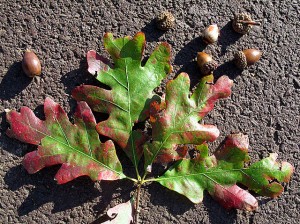Oak
Botanical Name: Quercus Alba
Folk Names: Jove’s Nuts, Juglans (Latin)Duir, White Oak
The oak is revered as a sacred tree, to the Greeks, Romans, Celts, Slavs and Teutonic tribes it was associated with the supreme god in their pantheon. Also, sacred to Zeus, Jupiter, Dagda, Perun and Thor, each of these gods had dominion over rain, thunder and lightning. It is no coincidence that oak trees seem to be more prone to lightning strikes than other trees, whether it be because of the wood’s low electrical resistance or the fact that they are often the tallest in the landscape.
Today, many believe that the Yule log should be made from it. When it is but ashes, those are strewn on one’s land to bring good fortune and wealth in the coming year. Oak leaves’ connection with rainfall is also survived in more recent folklore in a rhyme about which tree’s leaves appeared first, such as the Irish saying:
If the oak before the ash,
Then we’ll only have a splash.
If the ash before the oak,
Then we’ll surely have a soak!
“A tree as long-lived and strong as the oak naturally offers magical protection.”
Deities: Cybele, Dagda, Dianus, Erato, Hecate, Heme, Janus, Jupiter, Pan, Rhea, Thor, Zeus
Element: Fire (Courage, Exorcism, Health, Lust, Protection, Strength)
Gender: Masculine
Planet: Jupiter (Money, Prosperity, Legal Matters, Luck, Protection)
Powers: Protection, Health, Money, Healing, Potency, Fertility, Luck
Magical Uses:
Decorate altars with leaves as early as Lammas and Samhain.
- Acorns are beaded and worn for fertility
- Carrying any piece of the oak draws good luck.
- Plant an acorn in the dark of the Moon to receive money.
- Carrying an acorn increases fertility and strengthens sexual potency.
- If you can catch a falling oak leaf you shall have no colds all winter.
- The bark may be gathered and dried, then ground and used as an incense to invoke or honor any of the deities associated with the it.
- The oak’s association with Vesta and fire festivals lends itself to working with this herbal tree in conjunction with elemental fire.
- When a person is sick, place oak wood in the fireplace to “draw off” the illness.
- Make a charm from oak. Take two equal lengths of twig or of a small branch and bind them together in a cross. This represents keeping one’s self in balance with the four elements. It can also be hung in the house for protection.
- Acorns may be adapted into amulets and tokens. (Highly appropriate for the Samhain celebration)
- It is believed there is no wand as sacred as one made of oak.
- Collect an acorn and empower it throughout the winter, then plant it before the snow melts so that the new tree will be one of magic and power.
- Acorns placed in windows guard the entrance against lightning, and a piece of oak wood, carried, protects its bearer from all harm.
- Oak is used to bring protection against the ferocity of the elements and the dangers of life, and we use oak to ask for divine assistance in having our needs met.
Ritual Uses:
- Include oak in the fire for your Midsummer ritual.
- The bark may be dried and powdered and used to unite one with the gods and goddesses.
- The Druids (traditionally) would not meet for rituals unless an oak was present, and the very words “oak” and “Druid,” some say, are related. Religious idols were fashioned from oak wood, and Witches often danced beneath the tree.
Medicinal Uses: Native Americans used White oak medicinally, it was valued for its antiseptic and astringent properties and used in the treatment of many complaints. The inner bark contains 6 – 11% tannin, and can be boiled and the liquid drunk in the treatment diarrhoea, intermittent fevers, coughs and colds, consumption, asthma, lost voice etc. The bark has been chewed as a treatment for mouth sores. Externally, it is used as a wash for skin eruptions, burns, rashes, bruises, ulcers etc and as a vaginal douche. It has also been used as a wash for muscular pains. The bark is best collected in the spring.
References:
- Catherine Yronwode: Hoodoo Herb and Root Magic
- umm.edu
- Paul Beyerl: A Compendium of Herbal Magick
- Scott Cunningham: Cunningham’s Encyclopedia of magical herbs
Note: Consult with a Physician or certified herbologist if you are seeking medical remedies. The information is not intended as medical advice. PagansWorld.org is not liable for the misuse of the herb listed above.
Thanks for stopping by! Well wishes to you all and have a great day!
Lisa





